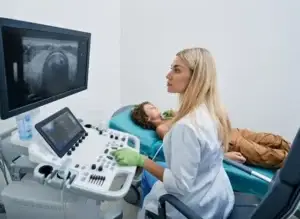 One of the most-discussed topics in health care at the moment is the issue of vaccinations. Though required by law to vaccinate their children, many parents are citing personal or religious reasons as excuses to refuse immunizations.1 Consequently, the United States has seen several outbreaks of diseases such as whooping cough and measles, afflictions that were previously thought to be effectively eradicated from the U.S. As an individual pursuing a medical assisting career, you are likely to get approached by parents who have questions about the safety of vaccinations. In an effort to dispel any myths that may be circulating, it is important that you know what scientific studies have shown about the safety and efficacy of vaccines.
One of the most-discussed topics in health care at the moment is the issue of vaccinations. Though required by law to vaccinate their children, many parents are citing personal or religious reasons as excuses to refuse immunizations.1 Consequently, the United States has seen several outbreaks of diseases such as whooping cough and measles, afflictions that were previously thought to be effectively eradicated from the U.S. As an individual pursuing a medical assisting career, you are likely to get approached by parents who have questions about the safety of vaccinations. In an effort to dispel any myths that may be circulating, it is important that you know what scientific studies have shown about the safety and efficacy of vaccines.
How vaccines work
The human immune system is responsible for fighting diseases in our bodies. In order to fight off infection, any time a virus or bacteria enters the body, the immune system produces special cells that are uniquely designed to destroy the harmful invaders.2 A vaccine works by introducing a neutralized version of a bacteria or virus into the bloodstream so the body can produce these special cells before it gets infected with the real thing. Once the immune system has had time to react to the inert virus, it will keep a store of specially made cells should it ever encounter that kind of infection again. If it does, it uses the cells it has already made in response to the vaccine to fight the harmful infection.
Which vaccines help children
In order to help the U.S. population develop an immunity to deadly diseases like whooping cough, measles, mumps and rubella, Congress enacted the Vaccines for Children program in 1993.3 The hope was to have these diseases go the way of polio, which was effectively destroyed in the U.S. after the widespread dissemination of an especially powerful vaccine. The program aims to have 90 percent of children vaccinated so they become immune to these harmful diseases. After VFC was instated, vaccination rates rocketed to above 90 percent, the results of which have been phenomenal. The Centers for Disease Control and Prevention reports that of the 78.6 million children born between 1994 and 2013, the vaccination efforts of VFC will preclude 322 million illnesses and 21 million hospitalizations throughout their lifetimes.4 However, even with the demonstrable benefits that immunization has had, many parents over the last two years have been quick to opt out of giving their children vaccines.
Why parents refuse to vaccinate
It seems as though the greatest pushback against vaccines comes from white, middle-class, suburban families. The anti-vaccination movement is seen as an outcropping of the all-organic mindset. These parents do not want their kids to be injected with what they believe to be unnatural chemicals. Vaccine fears have been multiplied by various myths that have been refuted through careful scientific study. Here are a few of the most common false beliefs about vaccines that you may encounter as you pursue a career in medical assisting: Vaccines cause autism: A study published in 1998 by a British journal titled The Lancet claimed that there is a connection between vaccines and the development of autism.5 As a result, many parents still fear that by vaccinating their kids, they are increasing the chance that their children will develop autism. That study has since been completely debunked. Scientific studies can find no link between vaccinations and autism. In order to fully drive that point home, the Journal of Pediatrics published a study that looked at children with known cases of autism and their vaccination history. They found that across the board, vaccinating children does not increase the likelihood that they will develop autism.6 Vaccines contain toxic mercury: Vaccines are created from biological material and thus must be protected from mold growth and bacterial contamination. Vaccine manufacturers used to use a compound called thimerosal to protect against these dangers. Thimerosal is made using a heavy metal element called mercury. This naturally occurring metal is toxic in high doses. Despite the lack of scientific evidence that the miniscule amount of mercury in thimerosal had any harmful health effects whatsoever, the U.S. Public Health Service decided to phase it out of all recommended vaccines. Currently, the only vaccines that include thimerosal are those for the flu that come in multi-dose vials.7 The preservative is necessary in these instances to prevent the introduction of potentially deadly bacteria to vials that contain more than one dose of the vaccine. The vaccination schedule overwhelms the immune system: Often, infants are immunized with a number of different vaccines in a relatively short period of time. Opponents of vaccinations worry that this immunization schedule introduces too much to the developing immune system of a young child. Despite an increase in the number of vaccines today’s children receive, the actual amount of the active ingredients that kids are exposed to has decreased.8 In addition, studies have shown that increased vaccine exposure poses no elevated health threat.9 1“How the anti-vaccine movement is endangering lives,” Puneet Kollipara, The Washington Post, 5 May 2014, http://www.washingtonpost.com/blogs/wonkblog/wp/2014/05/05/how-the-anti-vaccine-movement-is-endangering-lives/ 2 “How Vaccines Prevent Diseases,” Centers for Disease Control, 8 March 2012, http://www.cdc.gov/vaccines/parents/vaccine-decision/prevent-diseases.html 3 “How the anti-vaccine movement is endangering lives,” Puneet Kollipara, The Washington Post, 5 May 2014, http://www.washingtonpost.com/blogs/wonkblog/wp/2014/05/05/how-the-anti-vaccine-movement-is-endangering-lives/ 4 “Benefits From Immunization During the Vaccines for Children Program Era – United States, 1994 – 2013,” Cynthia G. Whitney, MD et al., Centers for Disease Control, 25 April 2014, http://www.cdc.gov/mmwr/preview/mmwrhtml/mm6316a4.htm 5 “How the anti-vaccine movement is endangering lives,” Puneet Kollipara, The Washington Post, 5 May 2014, http://www.washingtonpost.com/blogs/wonkblog/wp/2014/05/05/how-the-anti-vaccine-movement-is-endangering-lives/ 6 “Increasing Exposure to Antibody-Stimulating Proteins and Polysaccharides in Vaccines Is Not Associated with Risk of Autism,” Frank DeStefano MD MPH et al.,The Journal of Pediatrics, 6 March 2013, http://www.jpeds.com/webfiles/images/journals/ympd/JPEDSDeStefano.pdf 7 “Understanding Thimerosal, Mercury, and Vaccine Safety,” Centers for Disease Control, February 2013, http://www.cdc.gov/vaccines/hcp/patient-ed/conversations/downloads/vacsafe-thimerosal-color-office.pdf 8 “How the anti-vaccine movement is endangering lives,” Puneet Kollipara, The Washington Post, 5 May 2014, http://www.washingtonpost.com/blogs/wonkblog/wp/2014/05/05/how-the-anti-vaccine-movement-is-endangering-lives/ 9 “Increasing Exposure to Antibody-Stimulating Proteins and Polysaccharides in Vaccines Is Not Associated with Risk of Autism,” Frank DeStefano MD MPH et al.,The Journal of Pediatrics, 6 March 2013, http://www.jpeds.com/webfiles/images/journals/ympd/JPEDSDeStefano.pdf



